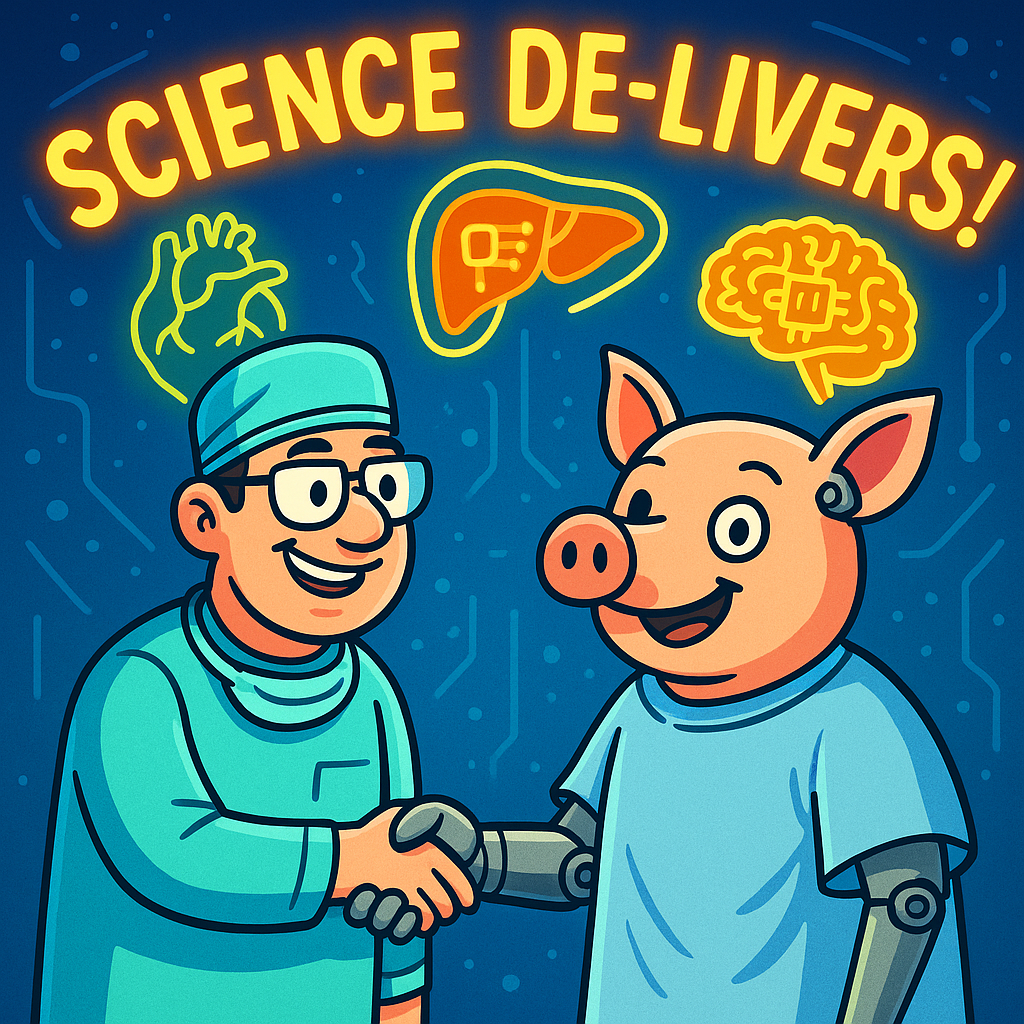
From Transplants and Xenotransplantation To Transhumanism and Health + Wealth Optimization: Science De-livers—Or Are We Trying to Play God?
🧬 Subtitle: We Don’t Mean to Lung for a Good Joke, But Are We Pushing Recycling Too Far?
It finally happened: surgeons in China just transplanted part of a genetically modified pig liver into a human being—and it worked for more than a month.
Yup. 🐷➡️🧍♂️
In the most extraordinary display of “Porkfolio diversification” to date, Chinese doctors pulled off what might be the first successful xenotransplantation of its kind—cross-species organ replacement—and the result might redefine medicine, ethics, and your next insurance premium.
⚙️ The Science: Bacon With a Purpose
Surgeons at the First Affiliated Hospital of Anhui Medical University transplanted a section of pig liver into a cancer patient whose own organ was failing.
The pig liver immediately began producing golden-yellow bile (sounds like a craft cocktail 🍸) and synthesizing essential proteins. For 38 days, it performed metabolic miracles—until complications forced doctors to remove it.
The man’s own liver, now recovered thanks to the pig’s temporary help, kept him alive another 133 days. The study was published in the Journal of Hepatology on October 8, 2025.
Lead surgeon Beicheng Sun summarized the triumph beautifully:
“The xenogeneic organ not only survived short term but also performed physiological functions.”
Translation: it didn’t just sit there—it actually worked.
You can read the original coverage via Scientific American 🧠🐖.
❤️ Organ Recycling, 2.0
The liver, you’ll recall, is the only organ that regenerates. So the operation was designed as auxiliary transplantation—a sort of “backup battery.”
The pig’s liver was grafted in to keep the patient alive while the human part healed.
That’s not just clever medicine—it’s ultimate recycling.
And yes, surgeons de-livered.
We at FUNanc1al used to disapprove of organ transplants...
…but we’ve had a change of heart. ❤️🔥
🐷 But Wait — Was the Pig OK With It?
This is where things get philosophical (and a little Monty Python).
Did anyone ask the pig how it felt?
Imagine the conversation:
Doctor: “Good news! You’re going to save a life.”
Pig: “Bad news: I only have one liver.”
Ethicists call this a “repurposing dilemma.” We call it “PETA meets IKEA.”
Still, xenotransplantation could soon move from pigs to primates to… who knows, 3D-printed dolphins?
The U.S. FDA already approved clinical trials for pig kidney transplants. Next on the list: ex vivo pig liver perfusion—using the organ outside the body as a temporary life-support filter. NIH reports initial costs for basic brain-machine interfaces (BMIs) are in the $5,000–$10,000 range, though this does not include ongoing support. This initial cost generally refers to non-invasive or low-cost experimental devices, with more advanced invasive interfaces being significantly more expensive; xenotransplants will likely start much higher.
🤖 From Pigs to Cyborgs: Transhumanism Steps In
Let’s zoom out.
If we can integrate animal organs into humans, the next logical step (or terrifying leap) is integrating robotic systems and AI into humans.
Welcome to Transhumanism 101 — the idea that we can “upgrade” Homo sapiens the way Apple upgrades iOS.
Future enhancements might include:
-
🧠 Brain–Computer Interfaces (BCIs) to boost memory, processing speed, or mood (because who doesn’t want “Happy Mode 2.0”?). Medical-grade invasive interfaces, which require complex surgery, can cost hundreds of thousands of dollars. The NIH funds various brain-computer interface (BCI) projects. For example, in 2021, the NIH backed Synchron's BCI with a $10 million grant to launch its first U.S. clinical trial.
-
🦿 AI-powered prosthetics that feel more natural than limbs you were born with.
-
👁️ Augmented senses—see in the dark, hear Wi-Fi, maybe taste sarcasm.
-
⚙️ Nanobots repairing cells from the inside, giving “internal maintenance” a whole new meaning.
At that point, “organ donor” becomes “hardware license agreement.”
⚖️ Ethics, Money, and Mayhem
All this progress comes with its share of dilemmas:
1️⃣ Societal inequality – if only billionaires can afford bionic upgrades, the gap between “enhanced” and “unenhanced” could make today’s class divide look quaint.
2️⃣ Erosion of identity – when half your brain runs on ChatGPT 13.0, who’s really doing the thinking?
3️⃣ Security risks – hackers could literally get inside your head.
4️⃣ Autonomy – will “keeping up with the cyborgs” become the new peer pressure?
5️⃣ Bias – if the AI inside you inherits human bias, congratulations, you’re now personally prejudiced by proxy.
💰 The Price Tag on Playing God
So, how much would it cost to become part robot, part pig, and all profit potential?
Current tech gives us hints:
| Technology | Status | Cost Range |
|---|---|---|
| Brain–Computer Interface | Experimental | $5k–$10k |
| Advanced Bionic Prosthetics | Clinical | $20k–$100k |
| DIY RFID/NFC Implants | Consumer | Under $250 |
| Full AI–human integration | Theoretical | Millions 💸 |
Between the custom hardware, elite surgical teams, and ethical paperwork thicker than a Tesla manual, the first fully enhanced human could cost more than an NFL franchise.
You can browse early tech and pricing data at NIH, Open Bionics, or skim various journals of law and ethics for legal considerations.
🧩 So… Are We Still Human?
The more we blend biology and technology, the blurrier the boundaries get.
When your liver’s half pig, your arm’s half robot, and your brain’s half AI, you’re either the future of evolution—or a walking startup.
Either way, healthcare and wealthcare are merging. “Health + Wealth Optimization” isn’t science fiction—it’s the next trillion-dollar industry.
🧠 FAQ
Q: What is xenotransplantation?
A: The transplantation of living cells, tissues, or organs from one species into another—usually animals to humans. Think cross-species organ swap, minus the dating app.
Q: What’s the main ethical concern?
A: Whether using animal organs and genetic modification crosses moral or ecological lines—and whether the pig signed a release form.
Q: How far are we from full AI-human integration?
A: Decades away. Current tech is still expensive, experimental, and often wired with more bugs than benefits.
Q: Could we become immortal?
A: Maybe… but imagine the maintenance plan.
⚡ Quick Take / TL;DR
🧬 Pig livers can now keep humans alive (for a while).
🤖 Transhumanism is next—humans + AI + bioengineering.
💸 Costs will be astronomical — and existential.
🧠 Ethics? Complicated.
🐷 Pigs? Still not thrilled.
🧾⚠️📢 Fun Disclaimer: 🧾⚠️📢
This article is for informational and comedic purposes only.
No pigs, livers, or philosophers were harmed during its creation.
Please consult your doctor before attempting self-xenotransplantation or installing ChatGPT into your frontal lobe.
This article contains traces of optimism and biodegradable humor. 🌱
We love science and technology — but most of all we love to smile and meme.
We sell jokes and opinions — and yes, we’re billing your sense of humor. 🎪💸💥
Invest at your own risk. Love at any pace. Laugh at every turn. 😄
🧭 Want More Like This?
👉 Head over to our Tech & Innovation Hub or our News & Perspectives with a Different Lens hub
👉 Browse our Funanc1al Wellness Hub for body insights with a wink and a plank
👉 Explore our Foodies Travel Hub for even more fun!
👉 Check our satirical finance series: “We the Spenders” (Coming soon)
👉 Or explore our Funanc1al Political Humor Roundup (Due anytime, if you dare to go deep)
👀 Want to stay relevant (and entertained)?
Visit Funanc1al.com — because we cover serious ideas with unserious emoji.
Quick links
Search
Privacy Policy
Refund Policy
Shipping Policy
Terms of Service
Contact us
About us
FUNanc!al distills the fun in finance and the finance in fun, makes news personal, and helps all reach happiness.
